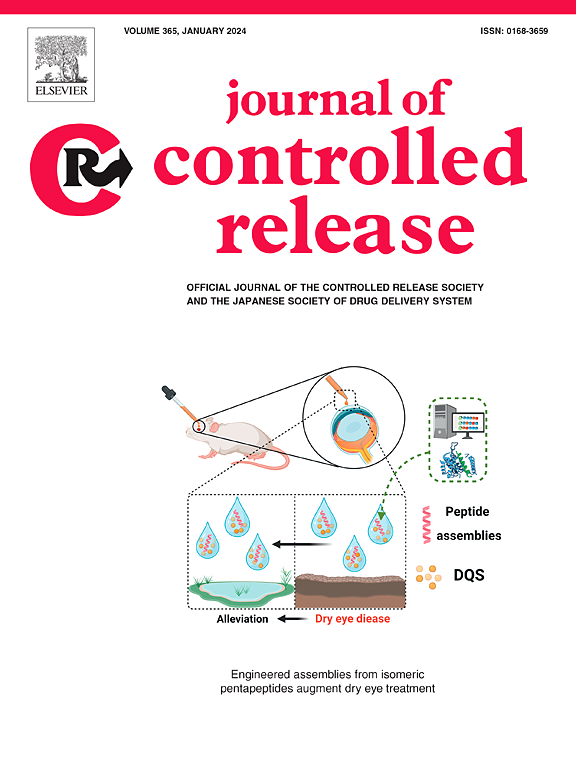“三合一”热敏凝胶系统,增强粘液和生物膜渗透治疗外阴阴道念珠菌病
IF 10.5
1区 医学
Q1 CHEMISTRY, MULTIDISCIPLINARY
引用次数: 0
摘要
阴道粘液和自洁行为等女性特殊的生理屏障给外阴阴道念珠菌病(VVC)的治疗带来了巨大挑战,而真菌生物膜导致的耐药性又限制了现有抗真菌药物的应用。基于此,我们设计了一种 "三合一 "热敏凝胶系统(AF/BP Gel),其中装载了抗生物膜纳米颗粒(AF NPs)和粘液渗透辅助纳米颗粒(BP NPs),以实现阴道粘附,同时增强粘液和生物膜的渗透。AF NPs载入了法尼醇(FAR)和两性霉素B(AMB),FAR是法定量传感分子之一,可干扰生物膜相关基因,如ALS3、HWP1、RAS1、CPH1、EFG1、NRG1、TUP1、UME6,并驱散成熟的生物膜,从而与AMB发挥协同抗生物膜作用。BP NPs含有菠萝蛋白酶(BRO),能清除AF NPs的粘液屏障,帮助其深入感染部位。这两种纳米粒子利用热敏凝胶基质均匀、持久地到达阴道粘膜表面,克服了阴道自洁的障碍。AF/BP 凝胶在体外和体内均显示出极强的抗白色念珠菌活性,并极大地改善了 VVC 小鼠的炎症状况。总之,这种 "三合一 "热敏凝胶系统可以克服多种生理障碍,抵抗不同时期的生物膜,为治疗阴道相关感染提供了一个新平台。本文章由计算机程序翻译,如有差异,请以英文原文为准。


A “three-in-one” thermosensitive gel system that enhances mucus and biofilm penetration for the treatment of vulvovaginal candidiasis
The special physiological barriers of women, such as vaginal mucus and self-cleaning behavior, pose great challenges for the treatment of vulvovaginal candidiasis (VVC), and the drug resistance caused by fungal biofilms limits the application of existing antifungal drugs. Based on this, we designed a “three-in-one” thermosensitive gel system (AF/BP Gel) loaded with antibiofilm nanoparticles (AF NPs) and mucus penetration-assisting nanoparticles (BP NPs) to achieve vaginal adhesion while enhancing mucus and biofilm penetration. AF NPs were loaded with farnesol (FAR) and amphotericin B (AMB), and FAR is one of quorum sensing molecules which can interfere with biofilm-related genes such as ALS3, HWP1, RAS1, CPH1, EFG1, NRG1, TUP1, UME6, and disperse mature biofilm, thus playing a synergic antibiofilm role with AMB. BP NPs was loaded with bromelain (BRO), which cleared the mucus barrier for AF NPs and help it penetrate deep into the infection. These two kinds of nanoparticles use the thermosensitive gel matrix to reach the surface of the vaginal mucosa uniformly and persistently to overcome the obstacle of vaginal self-cleaning. AF/BP Gel showed great anti-candida albicans activity in vitro and in vivo, and greatly improved the inflammatory conditions in VVC mice. Overall, this “three-in-one” thermosensitive gel system can overcome multiple physiological barriers and resist different periods of biofilm, providing a new platform for treating vagina-associated infections.
求助全文
通过发布文献求助,成功后即可免费获取论文全文。
去求助
来源期刊

Journal of Controlled Release
医学-化学综合
CiteScore
18.50
自引率
5.60%
发文量
700
审稿时长
39 days
期刊介绍:
The Journal of Controlled Release (JCR) proudly serves as the Official Journal of the Controlled Release Society and the Japan Society of Drug Delivery System.
Dedicated to the broad field of delivery science and technology, JCR publishes high-quality research articles covering drug delivery systems and all facets of formulations. This includes the physicochemical and biological properties of drugs, design and characterization of dosage forms, release mechanisms, in vivo testing, and formulation research and development across pharmaceutical, diagnostic, agricultural, environmental, cosmetic, and food industries.
Priority is given to manuscripts that contribute to the fundamental understanding of principles or demonstrate the advantages of novel technologies in terms of safety and efficacy over current clinical standards. JCR strives to be a leading platform for advancements in delivery science and technology.
 求助内容:
求助内容: 应助结果提醒方式:
应助结果提醒方式:


